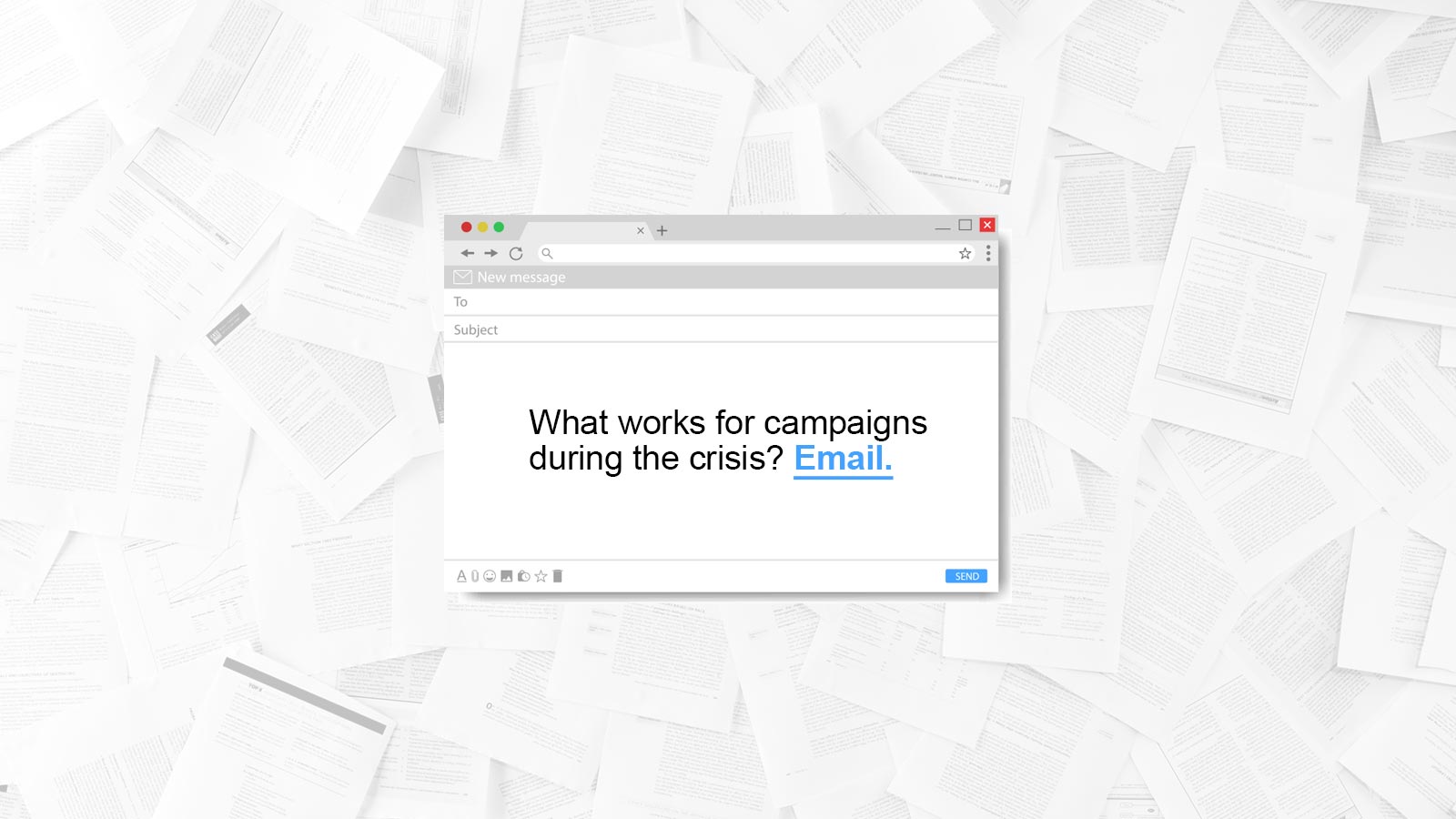
 As the COVID-19 outbreak intensifies, voters continue to look for calm, positive and informative leadership. They’re also looking for candidates who say something different from what’s on the news.
As the COVID-19 outbreak intensifies, voters continue to look for calm, positive and informative leadership. They’re also looking for candidates who say something different from what’s on the news.
Over the past few weeks, our team at MDW Communications has helped a number of our clients meet this need through targeted email. While many candidates running in local races have shied away from using email to communicate with voters and donors, we believe that email has been particularly effective during the COVID-19 crisis for two reasons. First, it’s helped candidates deliver helpful, supportive information to voters. Second, it’s helped smaller campaigns build healthy lists that will be useful later on in the campaign.
Today, I want to share some of our email efforts during the crisis and how they can inform strategies going forward.
What we’ve done
During the first few weeks of the COVID-19 crisis, our clients have suspended email fundraising because we all agree that asking people for money during this rapidly changing, economically unstable situation may do more harm than good, especially for smaller campaigns.
Instead, we’ve focused on promoting online campaign efforts, sharing news updates on the COVID-19 crisis, and offering helpful guidance. For the most part, our email clients have let the news and government outlets share information about school and business closures, stay at home orders, and other vital public health measures. Our clients have added value to the conversation by sending helpful emails on topics like mental health, debunking myths and even television recommendations.
What we’ve found
Our clients have seen universally better engagement with their email programs since the COVID-19 crisis began. Naturally, as people spend more time at home, they have more time to read emails. We also believe that most voters crave information and connection during this crisis.
But our clients have also communicated in a uniquely effective way by adding something new to the never-ending conversation on the virus: by sharing Netflix recommendations, asking voters to share their thoughts, or offering positive, action-oriented advice for parents with children, they’ve given voters a break from the minute-by-minute news updates on the pandemic.
The numbers on engagement are staggering for both moderately active and highly active email campaigns. Open rates, or the percentage of recipients who open an email, provide important top-line insights on email engagement. Two of our clients have increased their open rates by 100% in March. One incumbent, county-level elected official saw open rates double when compared to campaign emails sent between December and February. Another countywide incumbent who sends emails weekly or biweekly experienced the same increase.
We’ve helped candidates with more active email programs achieve similar results. One client running countywide experienced a 50% increase in the average open rate in just three weeks when they stopped fundraising, launched a virtual campaign, and started communicating with voters about COVID-19. Three of their emails achieved an open rate of over 35% during the pandemic. Another client, a first-time candidate running countywide for school board in Virginia, achieved astounding open rates of 42% and 45% on two emails about the COVID-19 crisis.
Just because people have opened more emails during the COVID-19 crisis doesn’t automatically mean they’re engaging with the content. However, we’ve found that on the whole, more people have clicked the links we’ve provided.
What should you do?
This data has different implications depending on your current email strategy. One thing is clear for everyone: communicating with voters via email has grown more effective during the COVID-19 crisis. That means that even if it’s not appropriate for smaller campaigns to raise money right now, sending targeted emails to voters, donors, and volunteers is an incredibly effective way to keep people engaged during this tumultuous time. Here are some more direct implications:
If you don’t currently have an email program, now is a good time to start one. People tend to be turned off by donation asks when they first start hearing from candidates and elected officials. Creating an email program now allows you to build a relationship with voters without asking them to take action. You’re likely to have a greater number of active email addresses — those who have opened an email in the past — if you start an email program now than if you start one when schedules are busy again. We believe this will result in a greater number of small-dollar donors, volunteers, and supporters later on in your campaign.
If you have an email program now, keep it going. You don’t want to be in a situation where campaigns go back to “normal” again, and your supporters haven’t heard from you since we began social distancing. Even if you can’t pursue your normal email fundraising program now, keeping your list engaged now will pay dividends later on.
Don’t send the headlines — send something different. Anyone can watch the news and find the latest school closures and COVID-19 statistics. Many Americans now want to hear about what’s harder to find: local charities, strategies for maintaining mental health during a period of isolation, or ways to stay involved in politics from home. Our clients have seen voters engaging with this content, and we think it’s valuable and often more positive than what they’ll find elsewhere. Many of us feel powerless, and we’re looking for ways to stay healthy, happy and positive during this crisis.
Use targeted email for digital organizing. If you’re running an active campaign, you know you can’t stop trying to reach voters just because you can’t hold in-person events. Use email to recruit volunteers to your Facebook town halls, virtual phonebanks and texting programs.
The bottom line
Many campaigns have decided the COVID-19 crisis is useless for their email programs because they can’t raise money. This view has remained prevalent among down-ballot and advocacy campaigns, who are already skeptical of targeted email.
We’ve found the opposite: Targeted email is more effective now than ever, especially for down-ballot campaigns. If you’re creative, on-message and sensitive to the crisis, you have a real opportunity to build a healthy email list and, most importantly, help your community weather this crisis.
___
Martin Page is a digital strategist for MDW Communications, a Florida-based political marketing agency. He has worked as a speechwriter and organizer for campaigns across the United States. An experienced writer, he draws on his research and writing experience to help campaigns make compelling arguments to donors and voters. He is a graduate of Princeton University.



